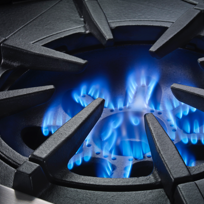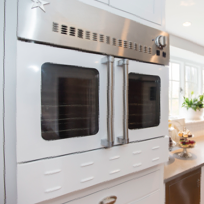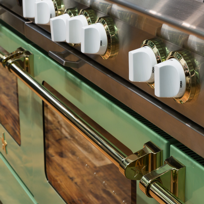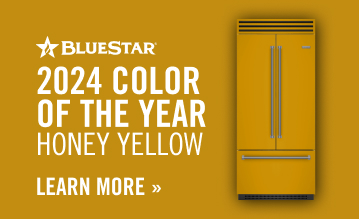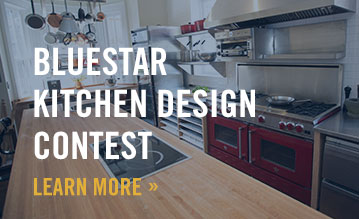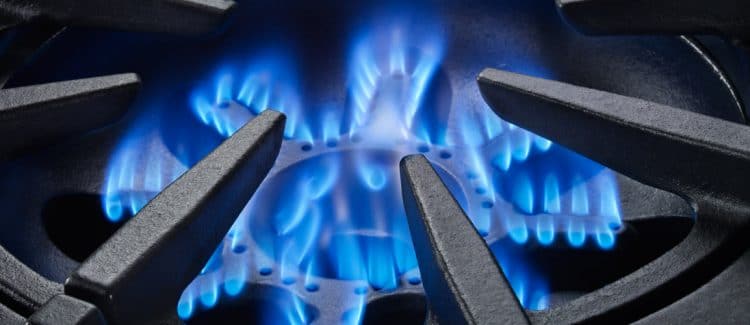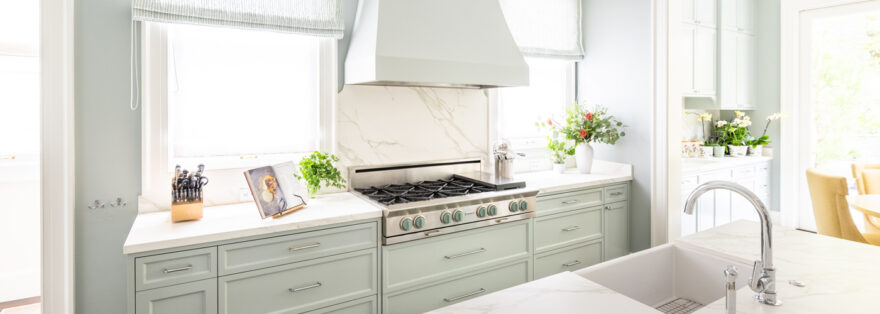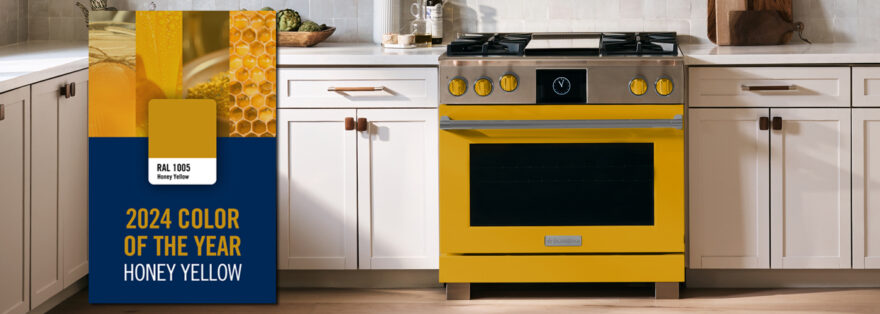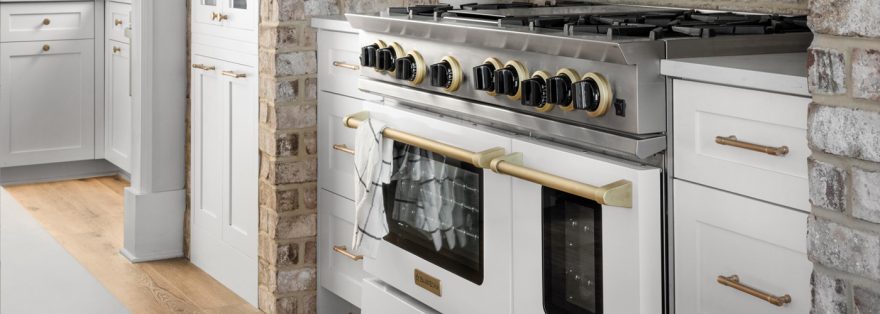Like soup and a sandwich, all-white kitchens and stainless-steel appliances have been a classic pairing in recent years. But like a salt-free diet, the look can be a tad bland. If that’s your take on it, you could paint your cabinets, or you could reconsider those stainless-steel appliances for something more palatable.
The Stainless Obsession: Is It Over?
“Stainless remains a popular premium finish, but we’ve seen a rise in what we call ‘stainless fatigue,’” says Eliza Sheffield, president of BlueStar, an upscale manufacturer of pro-style kitchen appliances.
“It’s been around for so long that people are feeling their kitchens are looking cookie-cutter, as opposed to the upscale, differentiated look that stainless always implied [in the past]. Clients are telling design professionals that they do not want a kitchen that looks like everyone else’s. People are discovering that small bursts of color can make a kitchen pop, and there’s no more predominant [place for this] accent than a range or a refrigerator.”
As Sheffield points out, just a “pop” can add interest without making a full-scale commitment to a single overall color. “For example, a colored range can work independently as a statement piece or as a subtle backdrop allowing cabinets to take center stage.”
And John Cioletti, president of Reno’s Appliances in Paterson, which sells BlueStar, says, “As an accent, color will set an appliance apart. It will change the whole look and feel of the kitchen.”
Does recalling the harvest gold and avocado green appliances of the 1970s make you color-shy? Sheffield advises trying it a little at a time, by adding a pinch of bright color on knobs or pulls, rather than the entire appliance. Or as Cioletti suggests, add color just on the front of an appliance. “That way, you still have a little stainless there.”
Mainstream Market or Upscale?
Right now, appliances with color are considered to fall into the “affordable luxury market.” According to Cioletti, “There’s premium, super premium, and it goes up from there.”
Generally, the price of a colored range starts between $4,000 and $5,000, and tops out at just over $15,000. And there are a number of manufacturers that carry them. For example, Reno’s carries BlueStar as well as Viking, KitchenAid, Elmira Stove Works, and Capital, as well as European manufacturers, AGA, Bertazzoni, and La Cornue. These companies manufacture appliances that come in stock colors or can be custom-finished in any color you choose.
If the new mainstream appliance “colors” ─ slate and black stainless steel ─ don’t do it for you, you might consider splurging just on one stand-out appliance in real color.
Now You’re Cooking
When it comes to choosing one appliance where they’ll opt for color, most people prefer the range. “Sometimes they’ll match the range to the hood,” says Cioletti, “although most times people with go with a different metal such as a copper or stainless steel. Usually, it’s usually a splash of color that people want; they’re not doing the whole suite of appliances. That’s unless they’re doing something like the Elmira Stove Works, which offers their specific retro look in the refrigerator and the range, with everything in that one color. But in most cases, it’s one or two items in the kitchen that you’re going to use as a focal point or an accent, even though most brands offer [a matching suite] as an option. For example, BlueStar now has a refrigerator to match their range, and they have a panel for a dishwasher that you can paint and mount on the front of a dishwasher. BlueStar is a hood manufacturer, too, so they can do that [in color], too.”
The Chill of It All
Another BlueStar company is Big Chill, began by manufacturing retro-style refrigerators in vintage-inspired colors. Now almost 15 years later, they offer three lines ─ Retro, PRO and Classic ─ of cooking and refrigeration appliances in both stock and custom colors. Says Orion Creamer, co-founder of Big Chill,
“Our appliances are all mid-range price points, somewhere between Kenmore and Sub-Zero.
“Our most popular line, Retro, is really not driven much by color trends. These are mostly classic colors — Turquoise, Beach Blue, Buttercup Yellow, Jadeite Green, and Pink. For the trendy look, however, we do have 200 custom colors available. Our PRO line has a contemporary palette of colors. But the vintage customer usually purchases our Retro line, and cherry red is a very popular color there.”
Sheffield cites Ruby Red and Cobalt as two popular BlueStar appliance hues. But she says, “Our customers can choose from over 750 colors and finishes and we can match any custom color, as well. We also have an interactive website tool, ‘Build Your Own BlueStar,’ allowing consumers to customize a Blue Star range – and now refrigeration – before buying.”
Making a “Perfect” Choice
Unlike painting a room, when it comes to choosing a color for an appliance, realistically there are no do overs. So, it’s important to choose a color thoughtfully. Cioletti recommends the RAL Color Chart, which is a system of displaying classic colors that have been arranged by hue, as a guideline.
As with paint, there are other ways to get a close if not perfect color match.
“People sometimes bring in a paint chip, which falls into the ‘classic color’ category. But not only that, others will bring in a picture that they want to match. That’s hard because the customer wants to get something that’s close. For example, someone might say, ‘I want to match my daughter’s eyes.’ That will depend on how the photo was taken. In that case, the customer has to pay the appliance manufacturer to produce a chip. This is a special order, and once customer signs off on it, it’s his. The order is not cancelable.”
A custom chip that is small, is usually free, but a large sample might entail a cost. “And if the chip isn’t exactly a match, you can usually have the manufacturer do it over again without incurring an additional charge.” Especially if you’re spending $15,000 on a range.
Waiting time, just for a custom color chip, can be from four to six weeks to get the chip, and then there’s another 12 weeks from the time you sign off on the color to the finished appliance. “It could be even half a year for a custom color,” says Cioletti.
Ready to Take the Plunge?
If you’re timid, you may want to go for a bite-size portion of color, on appliance knobs or pulls or on countertop appliances, which are offered in a limited number of stock colors. Or you may want to dive in with gusto.
“I’ve seen people mix and match over the years, but you really have to know what you are doing,” says Creamer. So, stick to a single color and a single appliance. However, adds Creamer, “I think larger kitchens can easily handle multiple appliances in color. If over-doing color is a concern, I’d recommend a softer palette.”
On the other hand, as Cioletti admits, “I’ve seen colors work that I thought never that would.”




